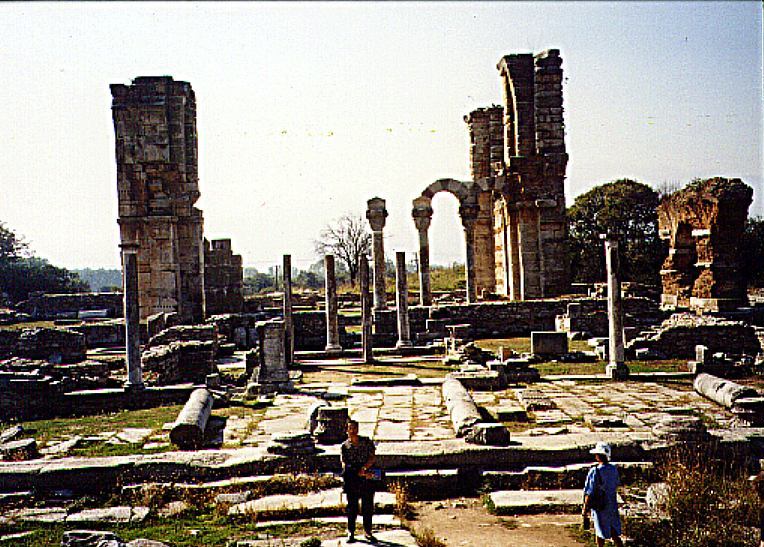 To Map
To MapPhilippi
 | Paul arrived in Macedonia around 50 C.E. We arrived October 17, 1998 C.E., almost 20 centuries later. Both were without fanfare. Paul arrived by boat, we arrived by plane. Paul landed at Neapolis (now Kavala), a small beautiful fishing village at the time (now a small, still beautiful, city)with an aquaduct
built at the time of sultan Suleyman the Magnificent (1521-1566) still pretty much intact. We arrived at Thessalonica, a city then, a bigger city now, the capital of the Greek province of Macedonia. Paul traveled about 9 miles on foot with a couple of companions along the Via Egnatia to Philippi. We traveled about 90 miles on a large air-conditioned tour bus with 18 other members of our tour along a modern highway to Philippi. We followed in the footsteps of Paul, but we left no footprints. Today, Philippi is an excavated ruin, dug up by French archaeologists from 1914 to 1938 and still being excavated today. When Paul arrived, it was one of the leading cities of Macedonia, founded in the 350 b.c.e. by Alexander the Great's father, Philip of Macedonia, and surrounded by walls. |
In 42 b.c.e., the army of Mark Antony and Octavian (later Caesar Augustus--Luke 2:1) defeated the army of Brutus and Cassius, the assassins of Julius Caesar, on the Plain of Philippi. In honor of his victory Octavian made Philippi a Roman colony and settled the veterans of the battle there.
As a military town, there was not much commercial activity, although the Via Egnatia, the east-west highway linking the Aegean with the Adriatic Sea, runs through it. The dieties worshipped here would have included Roman gods, the emperor, and others whose cults developed locally. No synagogue ruins have been found, so it is assumed that the Jewish community was small and worshipped outside the town at a "place of prayer" near the river. We visited the traditional site where the first European convert was baptized, a wealthy female merchant named Lydia, whose business was selling an expensive purple dye (Acts 16:13-15). Her household, including slaves, were baptized along with her and the group began to meet at her house.The impressive ruins cover many acres and include the remains of a Roman theater, a sixth century Christian Basilica, and a Roman latrine (males only). A member of our group posed to demonstrate. Paul got into big trouble at Philippi for curing an insane teenage slave, according to Acts, and was thrown into prison. Was that Paul's prison cell? Traditionally, yes, the guide said; actually, no.
Why Paul decided to cross over from Asia to Europe, he doesn't say, but at least one author sees the trip from Troas to Neapolis as decisive for Western civilization (A.N. Wilson, Paul). The Book of Acts sees it as divinely inspired, the call of God which came to Paul in a vision (Acts 16:6-10). We found Philippi in ruins and according to some scholars, Paul found Macedonia socially and politically in ruins. "After more than a century of intermittent warfare and economic exploitation, Macedonia had become a largely devastated imperial province entirely subject to the whims and the instructions of the Roman governor, who resided in the port city of Thessalonica. . . . . On the coastal plain and among the cities through which Paul traveled, the Macedonians' traditional ethnic identities and institutions had been almost completely pulverized." [Horsley and Silberman, The Message and the Kingdom, 1997, p. 152]
On his way from Philippi to Thessalonica, Paul would have passed through Amphipolis and Appollonia (Acts 17:1). The towns have disappeared, but he would have seen the "Lion of Amphipolis," a monument to one of Alexander the Great's generals, which still stands.
| | To Thessalonica  |
